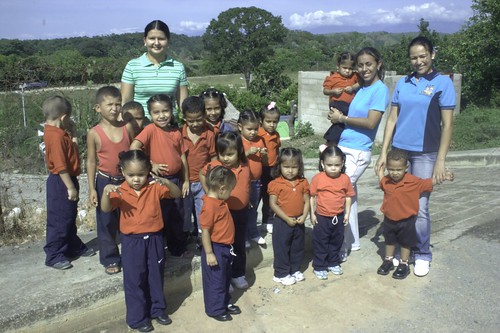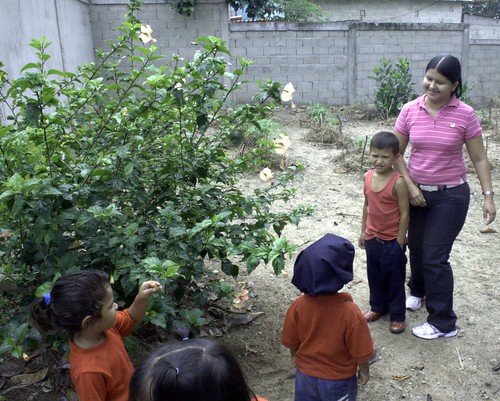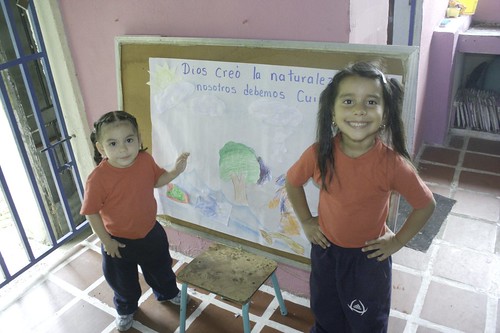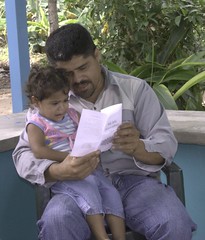
The Andes Mountains are part of our horizon. Usually they appear as mysterious shadows looming behind a heavy bank of clouds and mist. But when conditions are just right, you may distinctly see Pico Bolivar, the tallest mountain in Venezuela, from a spot on our bluff overlooking the river.

It was that clear Monday morning, October 5, when our new teacher, Yosaira Moreno, arrived. So after the singing of the national anthem and the opening prayer, the children were marched out (in single file) to the spot where they might see Pico Bolivar. Unfortunately, the clouds had again obscured Pico Bolivar, but they were able to see the outlines of some of the other peaks.
Then, for Wednesday's Bible lesson, I read Genesis 1:1 and asked the children what they thought of their view of the mountains. One confused little girl had thought we were going to meet Simon Bolivar (1783-1830), leader of Venezuela's War of Independence, therefore she was disappointed. But the rest were duly impressed by what they had seen of the mountains.
Reminding them that God made the mountains, the clouds and everything else in heaven and earth, I told them we can learn something about God in the beauties of nature. But God has revealed more about Himself in the Bible, His inspired Word, especially the story of Jesus, who suffered and died for sins and rose again on the third day. We sang some songs and Luz Maria took the children on a nature walk around the property. After that, they did some crafts based on the lesson.

We now have two preschool teachers assigned to our preschool by the state agency which provides the funds for the hot meal program and the teachers' salaries. The program ran short of funds for the meals last semester, but so far we are receiving the money for this semester.
The teachers are assigned to us because we do not have the funds to pay teachers ourselves. Yosaira and Nailu are not Lutherans, but have no problems with the religious component of our curriculum, for which myself and Luz Maria are responsible. Ideally we would have a Lutheran school staffed by Lutheran teachers, but all of the Lutheran schools in Venezuela face the difficulty of finding people with all of the desired qualifications -- and the commitment to serve.
Don't call it swine flu
I first heard the phrase "swine flu" when I was a college student. Early in 1976, 13 soldiers at Fort Dix, Georgia, became ill from a new type of flu virus and one of them died. Although the disease never spread beyond Fort Dix, the new virus (dubbed "swine flu") was believed to be a new form of the flu virus that caused a deadly global pandemic in 1918-1919. A $137 million national immunization program was approved by Congress and implemented in record time.
It was supposed to be a two-stage immunization. You were to get one shot which I received, then a booster shot. However, due to shortages of the vaccine, the fact the disease never really spread and that side-effects of the vaccine caused more deaths than the flu itself (25 nationwide vs. 1 soldier at Fort Dix), the program was suspended before I was able to get the booster shot.
So was I counted among the 24 percent of the U.S. population that, according to official sources, was immunized against the 1970s edition of the swine flu? I am not sure, although I would like to think so. It's sort of like Reformed views of baptism. Maybe you received the Holy Spirit through water and the Word, or maybe you didn't. Or perhaps simply making the decision to stay healthy (or accept Christ) was enough. Or maybe the only way to be really sure is if I can demonstrate the power to miraculously heal others.
At any rate, a new strain of the virus appeared in March 2009 and this time it seems the threat is more serious. According to the World Health Organization, as of September 27, worldwide there have been more than 340,000 laboratory-confirmed cases of this flu and over 4,100 deathsresulting from it.
The Centers for Disease Control and American Farm Bureau Federation would rather you not call it "swine flu," since there's not really much evidence that the virus is spread by handling pigs or pork products, but rather by the more technical name of "influenza A, subtype H1N1", or "A (H1N1) flu). Likewise in Venezuela, the disease is not referred to in official publications as "la gripe porcina" but rather "la influenza A (H1N1)".

So it was with the pamphlets that we handed out to the parents (or guardians) of our preschool children on Monday, Oct. 5. The pamphlets outlined the flu's symptoms and preventative measures.
Venezuela recorded its first case of the 2009 A (H1N1) flu on May 28. As of Oct. 3, Venezuela's Ministry of Health has confirmed 1,659 cases and 87 deaths resulting from the disease.
After the arrival of A (H1N1) flu in Venezuela, according to the Caracas-based Latin American Herald Tribune:
Vaccination centers were set up in parts of the country, with Zulia state in western Venezuela concentrating its facilities on the border with Colombia. An official said that the authorities had sufficient vaccine for 300,000 people, but it turned out this was vaccine for the conventional human form of influenza.
Meanwhile, the government says it has started registering people arriving on flights from the U.S., Mexico and Colombia, where cases of swine flu have been confirmed. Health workers and airport personnel at Caracas’s Maiquetia International Airport are asking passengers to fill out a form listing any flu symptoms.
Related articles by Zemanta:
![Reblog this post [with Zemanta]](http://img.zemanta.com/reblog_e.png?x-id=5b8ab380-d443-4eb9-ba37-3a541d01f38e)
No comments:
Post a Comment